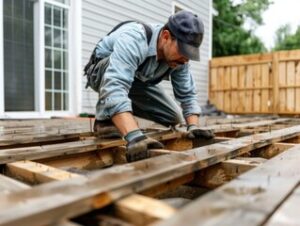The first thing you should do when building a deck is to learn your local residential building codes and find out what the setbacks are. Also, find out what the requirements are for a permit. Contact Deck Builders Baltimore County for professional help.
Pressure-treated lumber (PTL) is an essential material for outdoor construction projects, especially those that are exposed to moisture. It has a long lifespan and is resistant to rot and insect damage. It can also resist corrosion from metal fasteners. During the treatment process, wood is soaked in preservative chemicals to make it more durable. During this time, the chemicals permeate deep into the cellular structure of the wood, and this bonding process prevents the materials from leaching or dissolving over time.
PTL can be used for decks, patios, porches, fences and other outdoor structures. It is a versatile, cost-effective and eco-friendly building material. However, before you use it in your home or for an outdoor project, make sure that you understand how the treated wood will be used. This will help you choose the right type of lumber for your project and ensure that it meets the requirements of the local building code.
To treat the wood, it is placed into a large airtight chamber called a retort. The retort is sealed tightly and then flooded with the preservative solution. This process is repeated several times to ensure that the lumber is thoroughly saturated. The treated wood is then kiln-dried to ensure that it is dry and ready for its intended use.
Although kiln-dried wood has superior performance to untreated lumber, it is not suitable for applications that require significant flexural strength. It may also warp, twist, and shrink over time. In such cases, a deck made from natural hardwoods may be a better choice. Alternatively, you can build a deck using PTL and a concrete footing.
In addition to rot and insect resistance, PTL is also an excellent choice for structural components such as joists and beams. It can be sanded to remove splinters and is mildew-resistant. However, if you choose to build your deck with PTL, be sure to use hot-dipped galvanized nails, screws, bolts, and connectors.
In addition to being a great alternative to natural wood, PTL is much more affordable than redwood and cedar. It is available at most lumber supply stores. In fact, it is one of the most popular types of decking. However, be careful to avoid Ipe, a tropical hardwood that is not environmentally sustainable. This material is illegally sourced from old-growth forests in South America.
Concrete footings
Concrete footings support the weight of foundation walls and prevent structures from buckling or sinking. They also distribute vertical loads, preventing stress from concentrated areas and reducing the risk of structural damage. They are typically made of steel-reinforced concrete, although the International Residential Code allows builders in some locales to pour extra-thick foundation walls and skip the footings altogether.
There are many different types of concrete footings, each tailored to specific construction needs and conditions. Builders choose the best footing for their project based on local soil conditions, engineering specifications, and design requirements. They also consider construction costs and schedules. Choosing the right materials and tools is an important factor, as they can significantly affect the quality and strength of the concrete footings.
Construction of concrete footings starts with excavation and creation of formwork. This consists of a frame that holds the concrete during the mixing and pouring process. Formwork materials are usually wood boards or metal panels, and builders must use proper formwork techniques to ensure correct dimensions and quality of the concrete. They may also use rebar in the formwork to strengthen the footing and reduce the likelihood of cracking.
After the formwork is in place, builders mix and pour the concrete for the footing. They often use vibrating tools to remove air bubbles and ensure that the concrete is dense and properly compacted. Once the concrete is poured, it must be allowed to cure for a specified amount of time. This allows the concrete to gain strength and durability, ensuring a strong and long-lasting structure.
Once the concrete footings have been cured, it’s time to install the foundation stemwalls and other structural elements. This process can be time-consuming and labor-intensive, but it’s critical for building a strong and durable structure. It’s also crucial to inspect concrete footings regularly to identify and address issues that can affect stability. It’s recommended to conduct visual inspections at least once a year and hire a professional structural engineer for non-destructive testing every 5-10 years. Keeping up with these inspections will help minimize maintenance and repair costs in the future.
Galvanized metal connectors
Building a deck is an exciting project for homeowners, but it can also be a challenge. It is important to follow local building codes to ensure that the deck will be safe and up to code. A contractor can help you navigate these building codes and ensure that your new deck is safe for years to come.
A deck built with wood gives a natural look that can be tailored to fit your home. It is also an eco-friendly option, using materials that are recycled and renewable. However, it is not as strong as other types of decks, and it is susceptible to water damage. If you want to build a deck that can withstand heavy loads, it is a good idea to use galvanized metal connectors.
Many different kinds of metal connectors are available on the market, but they all share common features. These include threaded connections and flanged connections. The former connects to the end of a pipe with screws, and the latter uses flanges to create a connection that is both strong and flexible. Both methods are relatively inexpensive and require no welding, making them a cost-effective solution for many systems.
The materials used for preservative-treated wood can be corrosive to metal connectors and fasteners. Salt spray in coastal environments and some of the chemicals in preservatives can contribute to the corrosion. These corrosion problems can be reduced by using stainless steel or hot-dip galvanized metal connectors. These connectors should be used with preservative-treated lumber that has been treated with chromated copper arsenate (CCA).
Some metal connectors are made of non-corrosive materials, such as beryllium copper and phosphor bronze. Others are made of aluminum, and some have a galvanized coating. The type of connector you choose depends on the conditions where you intend to use it, such as temperatures, currents, and voltages.
Galvanized metal connectors can be painted with a good-quality oil-based spray paint. It is a good idea to test the paint on a small piece of scrap metal before applying it to your connectors. When painting, it is important to find a well-ventilated area and cover nearby surfaces to protect them from the spray. Also, it is a good idea to purge your cans regularly to prevent clogging and extend their life.
Decking
A deck is a great place to relax, socialize, and entertain. It can also be used as a platform for a garden or a rooftop patio. However, before starting a deck project, you should familiarize yourself with some key terms and building codes. These can help you make a safe and structurally sound structure that will last for years to come. If you’re planning a DIY deck, or working with a contractor, knowing these terms can be helpful in understanding your project.
Wood decking can be made from a variety of materials, but the most common is pressure-treated lumber. This material is treated with preservatives to protect it from mold and fungus, insects, and other pests. It is also very durable and can withstand harsh weather conditions. It’s important to use quality fasteners and hardware rated for use with treated lumber. The chemicals in the preservatives can corrode metal, so it’s best to use galvanized or stainless-steel fasteners for all structural connections.
In addition to the deck’s beams, joists, and posts, it also needs to be properly supported by a foundation. The foundation should be made of concrete or poured-in-place footings. The type of footing you choose will depend on where your deck is located and whether it’s attached to your home. In some cases, you may need to dig a larger footing for a multi-level deck or to accommodate large furniture and appliances.
The deck frame is made from joists and rim joists, which are connected to the foundation by ledger boards. Joists are generally built from pressure-treated lumber, and rim joists are typically made of a more durable species like redwood or cedar. A ledger board connects the deck frame to your house and must be properly attached with code-recognized hardware, including bolts with washers or lag screws. It’s also important to check local and homeowner association regulations regarding permit requirements and inspections for your deck project.
Stair stringers are the actual stairs you walk on, and they’re usually made from a combination of decking boards. The rise and run of the stair are also crucial factors for safety, as they determine how steep the stairs are.
